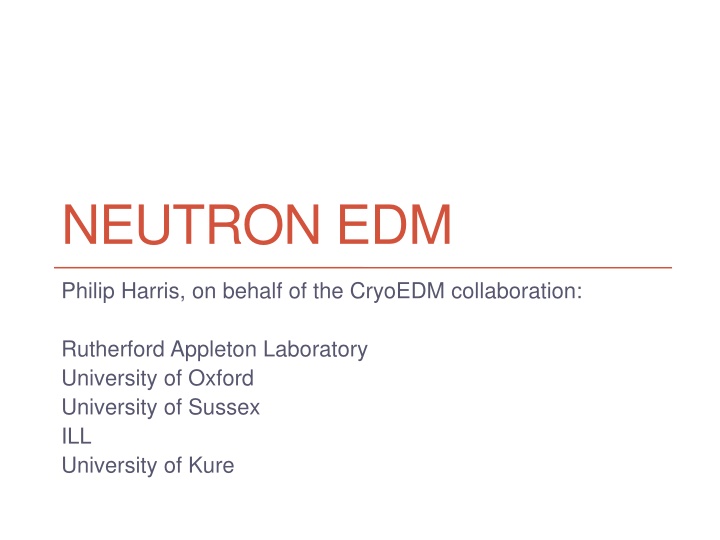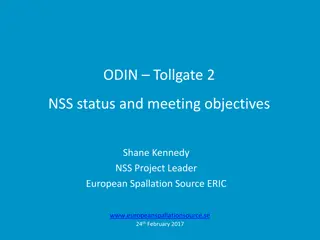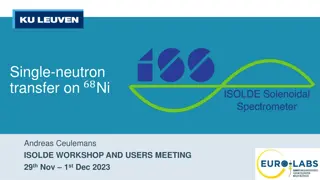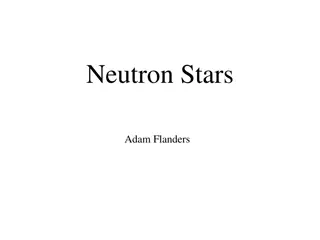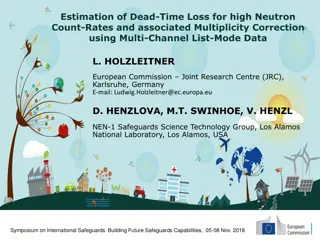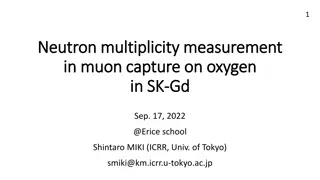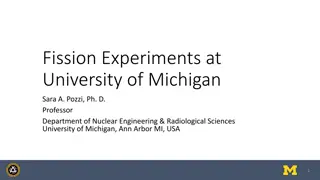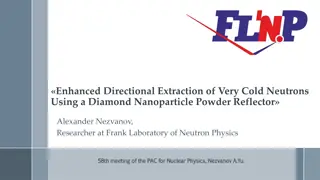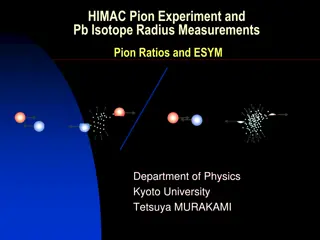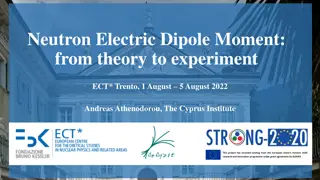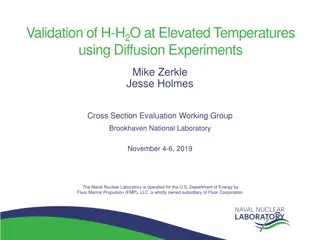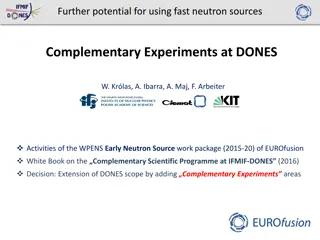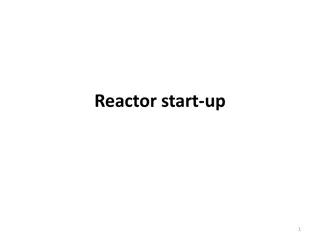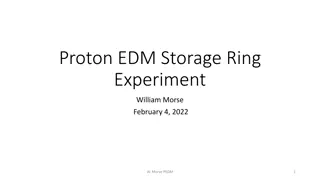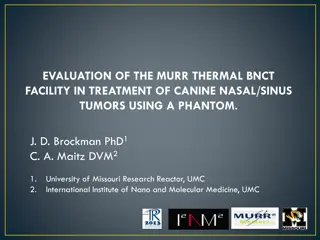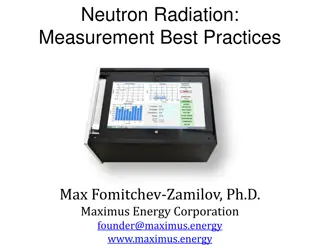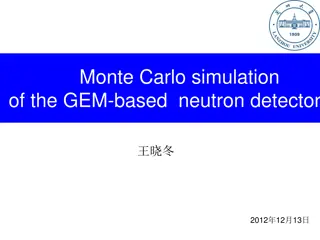NEUTRON EDM
The Neutron Electic Dipole Moment (EDM) collaboration has made significant progress in producing, storing, and transporting ultracold neutrons. They have achieved polarization in the source and are aiming to improve further. Plans for upgrades include moving to a new beamline, characterizing a more intense beam, and a major experiment upgrade involving cryogenics design changes and systematics improvements leading to a significant boost in sensitivity.
Uploaded on Feb 16, 2025 | 1 Views
Download Presentation

Please find below an Image/Link to download the presentation.
The content on the website is provided AS IS for your information and personal use only. It may not be sold, licensed, or shared on other websites without obtaining consent from the author.If you encounter any issues during the download, it is possible that the publisher has removed the file from their server.
You are allowed to download the files provided on this website for personal or commercial use, subject to the condition that they are used lawfully. All files are the property of their respective owners.
The content on the website is provided AS IS for your information and personal use only. It may not be sold, licensed, or shared on other websites without obtaining consent from the author.
E N D
Presentation Transcript
NEUTRON EDM Philip Harris, on behalf of the CryoEDM collaboration: Rutherford Appleton Laboratory University of Oxford University of Sussex ILL University of Kure
Technology Neutrons in HV in
Sensitivity sd=2aET N Successfully produced, transported, stored UCN, but need to reduce losses Achieved 60% polarisation in source, but must improve Successfully applied 10 kV/cm (same as previous expt); aiming for 20-30 kV/cm RT-edm: 130 s. So far we have 62 s cell storage time. sd=2aE TN (NB sensitivity/day is actually closer to )
Sensitivity in 2012 Room-temperature expt final sensitivity ~2E-25 ecm/day Took 12 years of incremental developments from known technology Systematics limited (geometric phase effect) We can come within factor 4-5 of this in 2012 by increasing detector area x10: technology now proved refurbishing damaged detector-valve: in hand applying ~70 kV (previously ~40 kV): should be straightforward opening beam aperture from 43 to 50 mm: depends on radiation levels retaining polarisation: superconducting material has been removed There may be additional improvements beyond this peak above background (detector improvement) Polarisation to 60% (improved guide field) Increasing cell storage lifetime (insulator bakeout) (we will achieve these by 2014)
Shutdown and move to new beamline Mid-2013: Have to vacate current location. ILL will shut down for a year; we will move to new dedicated beamline. New beam 4x more intense; and dedicated Due to become operational mid-2014 Beam must then be characterised (9A flux, divergence, stability, polarisation) We will then have access to the area (late 2014) to move our apparatus into it. M&O uplift requested to fund move and infrastructure in new location.
Upgrade 2013-15: Upcoming PPRP request Not yet fully costed Major upgrade to experiment: Cryogenics design changes: Pressurise the liquid helium: increase E field x 2-3 Upgrade from two-cell to four-cell system 2 x neutrons Cancellation of some systematic effects Installation of inner superconducting magnetic shield B-field stability improves x1000, for systematics Construction of non-magnetic SCV Improves depolarisation: better T2 Overcome geometric-phase systematic error Net result: Order of magnitude improvement in sensitivity Commensurate improvement in systematics
Sensitivity timeline Date Item Comment factor ecm/year 1.7E-26Baseline 1.7E-24 4.9E-25Proven 3.1E-25OK to 50 kV, lab tests suggest should work at 70 kV 2.5E-25Repair should be fine 1.7E-25Seen in source. Should transfer ok to cells. 1.4E-25Will increase radiation levels slightly, but should be ok 7.7E-26Almost certain undergoing mag. scan now to confirm 5.5E-26Quite likely by 2012, but we do not count on it by then 2.7E-26ILL produced this estimate 1.2E-26Depends on geometry match to new beam. 2002RT-edm 2010CryoEDM commission 2012Large-area detector 2012HV to 70 kV 2012Repair detector valve 2012Polarisation 60% 2012Aperture to 50 mm 2012Ramsey time to 60 s 2013See alpha peak 2014New beam 2014Recover missing input flux? 2014Improve cell storage lifetime to 100 s 2014Match aperture to beam 2015HV to 135 kV 2015Four-cell system 2015Polarisation to 90% 2013-15 Inner supercond. shield 2013-15 Cryogenics 2013-15 Non-magnetic SCV 3.5 1.6 1.3 1.5 1.2 1.8 1.4 2.0 2.2 8.3E-27Not guaranteed, but haven't yet tried most obvious solutions (e.g. bakeout), so improvement likely 6.4E-27Likely 1.5 1.3 3.3E-27Requires pressurisation. Lab tests show this is realistic. 2.3E-27Guaranteed part of upgrade 1.6E-27No known reason why not Lab tests on scale model shows factor 500 Included in upgrade Included in upgrade 1.9 1.4 1.5
Sensitivity and systematics Without upgrade, we may reach factor ~3 better stats than RT- edm (possibly better if storage lifetime improves significantly). Systematics is a different matter. Back-to-back cells (4-cell system) provide important cancellations Completely non-mag SCV would eliminate most of geometric-phase systematic (which limited RT-edm). 1 nT/m very difficult otherwise. Magnetic shielding controls fluctuations, reduces broadening of Ramsey fringes Changes to cryogenics would increase reliability (reduce down-time), reduce manpower burden, reduce He consumption... With upgrade, should reach factor ~10 improvement in stat sensitivity, with commensurate improvement in systematics.
